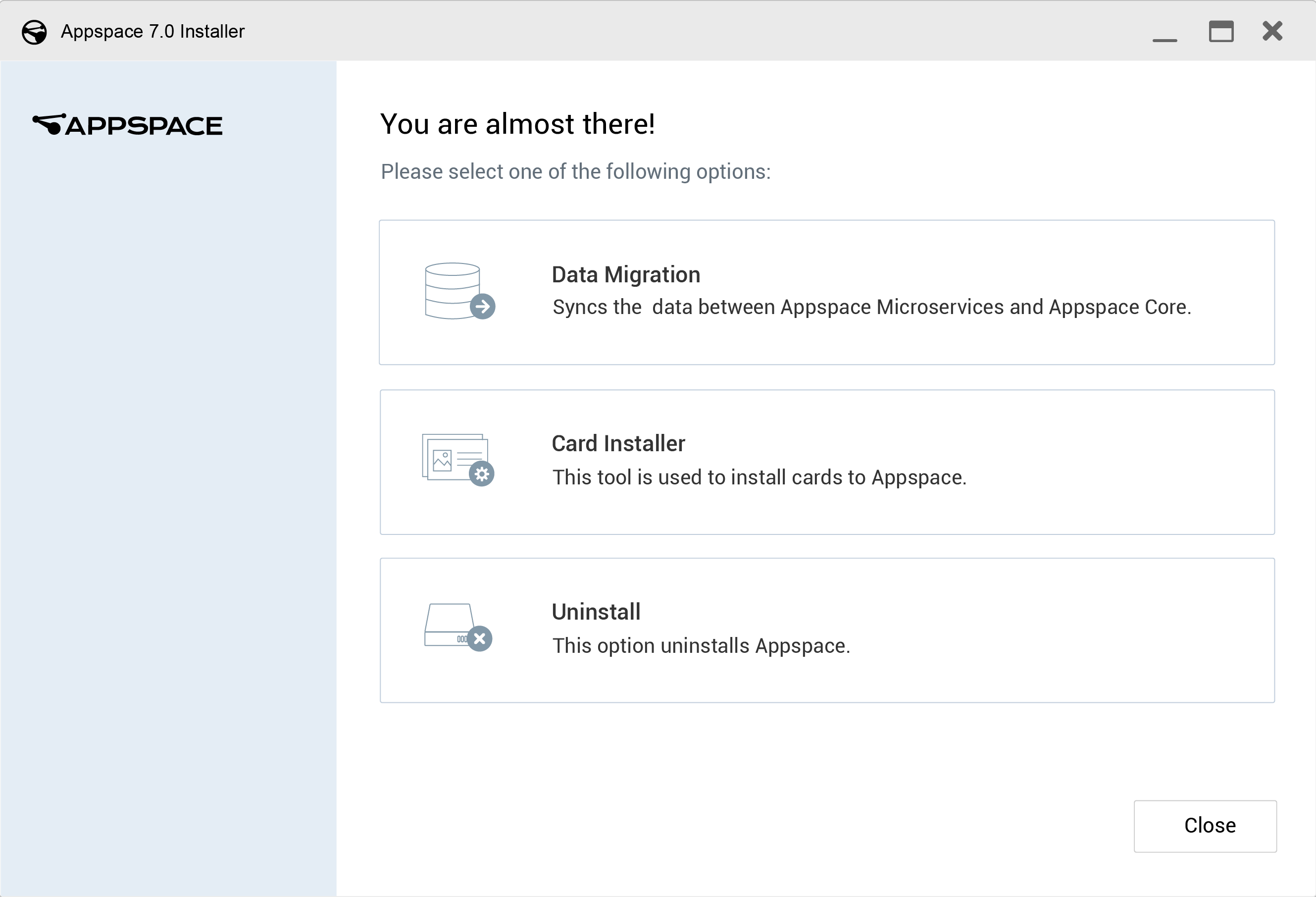Install Appspace 7.0 on-prem
This article provides the instructions to download, install, and configure the operating system, prerequisite software, and Appspace software, for a first-time install of an Appspace 7.0 on-prem deployment.
Please follow the instructions in this order:
- Install and Configure Operating System
- Download Prerequisite Software
- Install Prerequisite Software
- Configure Folder Permissions
- Install Appspace 7.0
Note
If you are an existing Appspace customer running an older version of Appspace on-prem and looking to upgrade our software, please refer to the Upgrade to Appspace 7.0 on-prem article.
Prerequisites
Please ensure you meet all the requirements listed in the On-prem system requirements article.
HTTPS is required for communications. Download and install a valid SSL (Secure Sockets Layer) certificate for the Appspace on-prem server. Refer to the How to Set Up SSL on IIS 7 instructions here: https://docs.microsoft.com/en-us/iis/manage/configuring-security/how-to-set-up-ssl-on-iis
Configure the DNS (Domain Name Server) with a FQDN (Fully Qualified Domain Name).
Turn off anti-virus software prior to installation. If unable to turn off anti-virus software due to company policies, configure the anti-virus software to exclude all Appspace folders and databases.
Important
When not turned off, anti-virus software blocks installer processes from running, which prevents the installation of some Appspace files. Overall installation time is also slower.
Install and Configure Operating System
Important
- Links to the installation instructions on the provider’s website are provided.
- Please ensure you take note of and complete the specific configuration required for each application, described in each step below.
Select and install the Windows Server 2012 R2 Standard Edition operating system (OS). Please note the specific configuration required for Appspace, as listed below:
Install Windows Server 2012 R2 as per instructions on the Microsoft website: https://technet.microsoft.com/en-us/library/hh831620.aspx.
Important
When installing the Windows Server 2012 R2 server, ensure that the Time and currency format is set to English (United States). This is the default setting.
This is to prevent a licensing issue, where the on-prem server is unable to add the pending license receipt. This is due to a date format mismatch between the Appspace cloud server, which is set with the M/d/yyyy date format, and the on-prem server, which may contain a different date format, if another locale is selected during the Windows server installation.

Install all the necessary updates for Windows Server 2012 R2 Standard Edition as per instructions on the Microsoft website: https://support.microsoft.com/en-us/help/3067639/how-to-get-an-update-through-windows-update
Important
Ensure that there are no pending Windows server updates, as there may be installation conflicts between the Appspace installation process and windows server updates being installed simultaneously in the background.
Install the Universal C Runtime update as per instructions on the Microsoft website: https://support.microsoft.com/en-us/help/2999226/update-for-universal-c-runtime-in-windows
Ensure the following options are checked:
Role-based or feature-based installation.
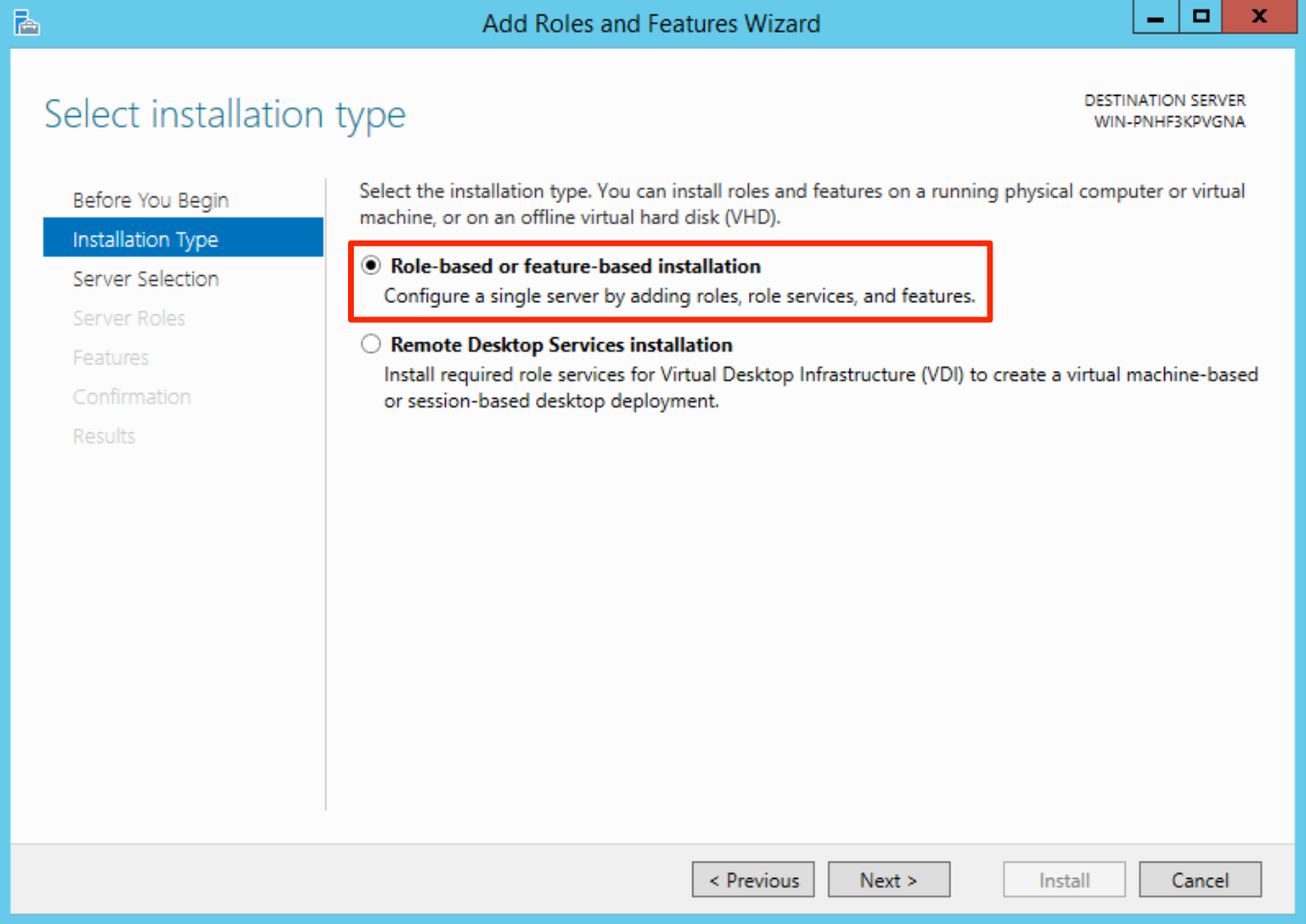
Select Appspace server from the server pool.

Web Server (IIS).
Ensure the following Web Server IIS services are selected:
Web Server (IIS)
Web Server
- Default Document
- Static Content
Performance
- Static Content Compression
- Dynamic Content Compression
Application Development
- .NET Extensibility 3.5
- .NET Extensibility 4.5
- ASP
- ASP.NET 3.4
- ASP.NET 4.5
- ISAPI Extensions
- ISAPI Filters
Management Tools
- IIS Management Console
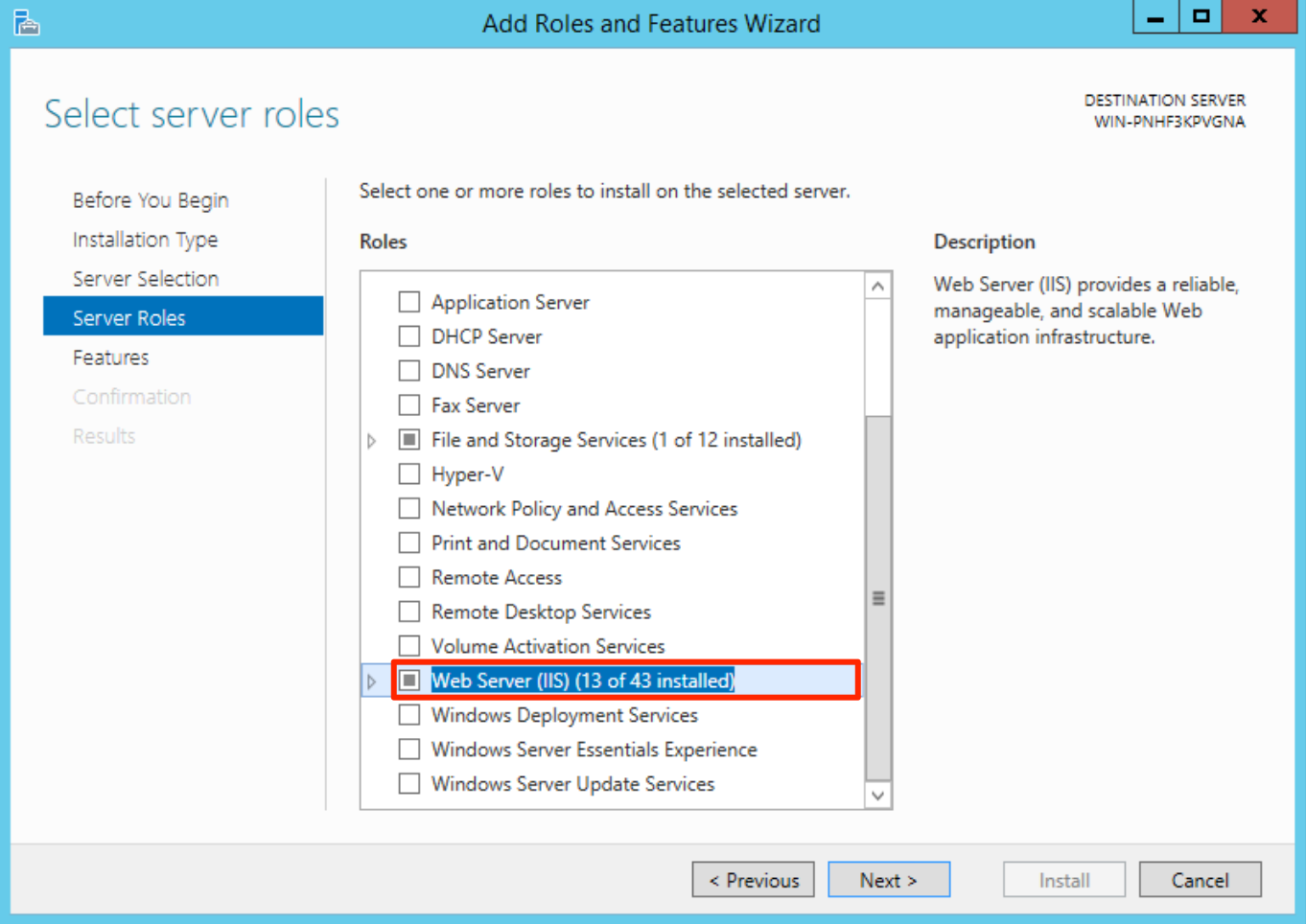
.NET Framework 3.5 Features and .NET Framework 4.5 Features.
Ensure the following .NET Framework features are selected:
.NET Framework 3.5 Features
- HTTP Activation
- Non-HTTP Activation
.NET Framework 4.5 Features
WCF Services
- HTTP Activation
- TCP Activation

Restart the Windows 2012 R2 server.
Proceed to configure the Secure Sockets Layer (SSL) for the server, by following the How to Set Up SSL on IIS 7 instructions here: https://docs.microsoft.com/en-us/iis/manage/configuring-security/how-to-set-up-ssl-on-iis
Once installed, restart the Windows 2012 R2 server and proceed to the next section.
Download Prerequisite Software
Disable the Internet Explorer Enhanced Security Configurations (IE ESC), which is enabled by default, as this blocks IE from downloading all files.
In Windows Server Manager, click On and in the IE Enhanced Security Configuration option, select the Off options for both Administrators and Users.
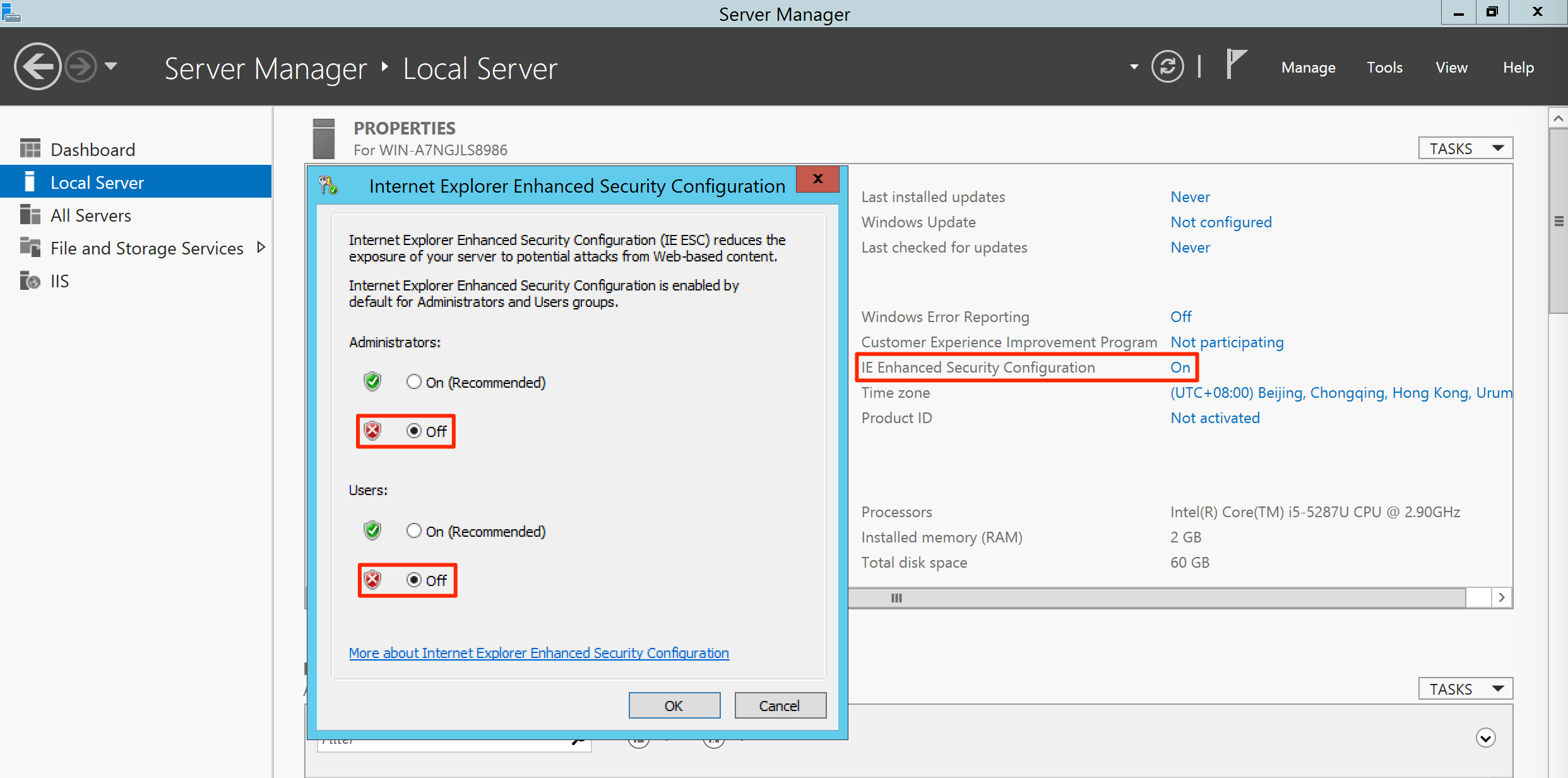
Warning
Only download these software and DO NOT install yet.
Download Microsoft .NET Framework 4.6.1: https://www.microsoft.com/en-my/download/details.aspx?id=49982
Download only one of the following database:
MySQL 5.7.x: http://downloads.mysql.com/archives/installer/.
MS SQL: Microsoft SQL Server 2012: http://www.microsoft.com/en-us/download/details.aspx?id=35575.
Please contact Appspace Support to get the latest Appspace Installer.
Proceed to install the applications as per the instructions in the next section below.
Install Prerequisite Software
Important
- Links to the installation instructions on the provider’s website are provided.
- Please ensure you take note of and complete the specific configuration required for each application, described in each step below.
- Please right-click each installer file and select ‘Run as Administrator’ to install.
Please install the prerequisite software downloaded earlier, in the following order:
Install .NET Framework 4.6.1. Follow the instructions here: https://msdn.microsoft.com/en-us/library/5a4x27ek(v=vs.110).aspx
Install and configure your preferred database:
Warning
- SQL passwords should NOT contain shell metacharacters such as !#’”`&; or spaces.
- The database credentials CANNOT be changed once Appspace has been installed.
- The database user account must not be deleted once Appspace has been installed.
MySQL:
Install MySQL 5.7 (Version 5.7.x). Follow the instructions here: https://dev.mysql.com/doc/refman/5.7/en/mysql-installer-setup.html
Select the Custom option on the Choosing a Setup Type window, and click Next to continue.

On the Select Products and Features window, ensure the following options are selected, and moved under the Products/Features To Be Installed section.
- MySQL Server 5.7.x (either the x86 or x64 version depending on your server)
- MySQL Workbench CE 8.0.x (either the x86 or x64 version depending on your server)
Warning
Only select these 2 options. Leave all the other options unchecked. It is important to make sure that the other options (such as MySQL Connectors) are NOT selected during the MySQL installation.
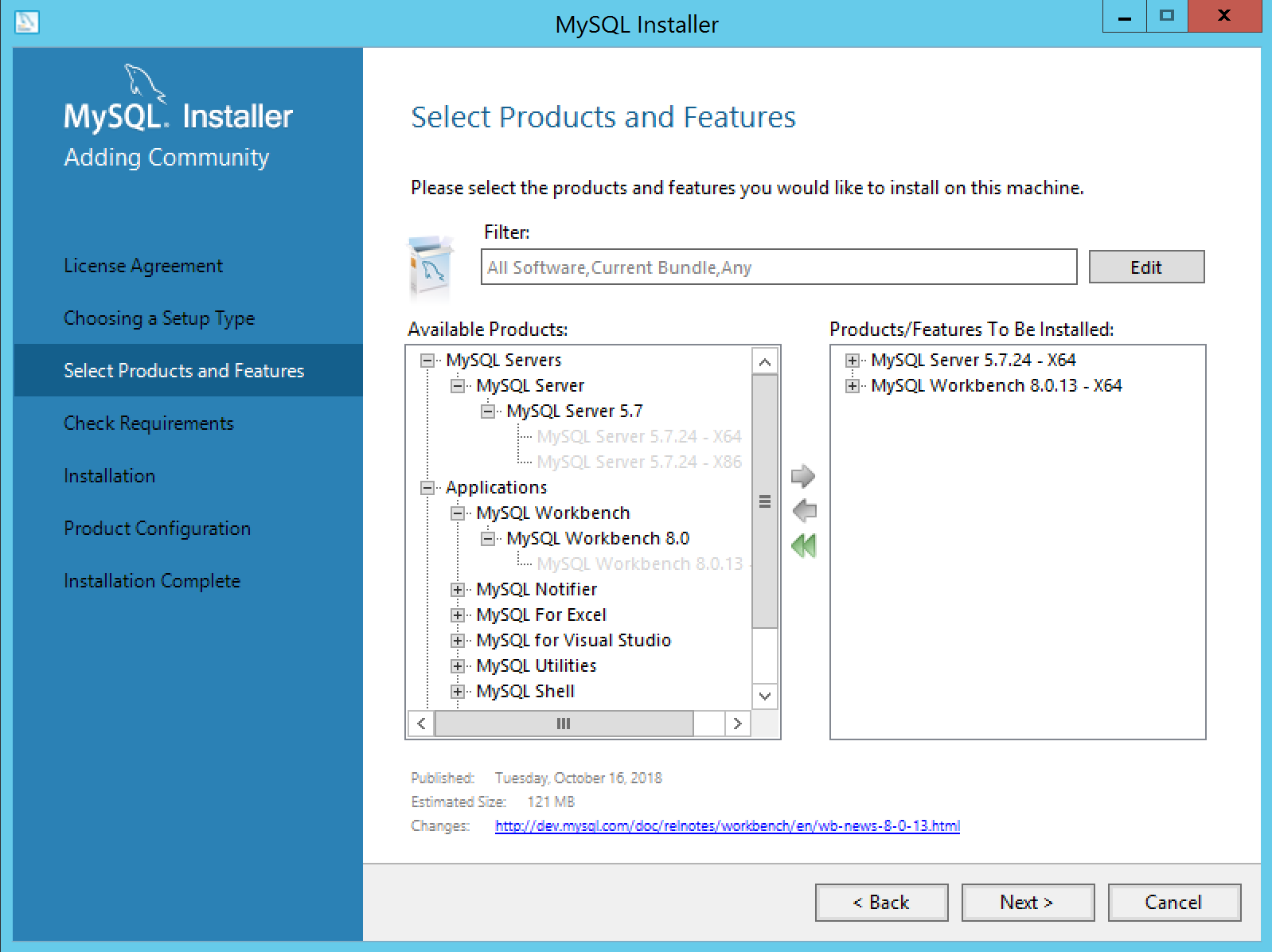
In the Group Replication window, select the Standalone MySQL Server/Classic MySQL Replication option.

In the Type and Networking window, do the following:
- Select Server Machine from the Config Type drop-down menu.
- Under Connectivity, check the TCP/IP checkbox, and set the Port Number to 3306.
- Check Open Firewall port for network access.
- Check Show Advanced and Logging Options.

In the Accounts and Roles window, enter in the MySQL Root Password

Warning
SQL passwords should NOT contain shell metacharacters such as !#’”`&; or spaces.
Configure MySQL Workbench. Follow the instructions in the MySQL Setup with MySQL Workbench article.
MS SQL
Install Microsoft SQL Server 2012. Follow the instructions here: http://www.microsoft.com/en-us/download/details.aspx?id=35575
In the Setup Role window, select the All Features With Defaults option.

In the Feature Selection window, keep all features that are selected by default.

In the Database Configuration window, select the Mixed Mode option. Ensure that at least one user has been assigned administrative permissions for Analysis Services.

Configure MS SQL Management Studio. Follow the instructions in the MS SQL Setup with SQL Server Management Studio article.
Proceed to the next section below.
Configure Folder Permissions
Grant read and write permissions to IIS_IUSRS for the following folders:
- C:/temp
- C:/Windows/Temp
- C:/Appspace
Warning
Failure to set permissions may result in a failed server install due to access restrictions.
Repeat the instructions below for each folder listed above:
Navigate to the temp folder on your Windows server. If you do not see the folder, create the folder in the C drive.
Right-click on the folder and select Properties.

Select the Security tab, and look for IIS_IUSRS in the Group or user names section.
On the next window, select the Add button to create the group name.

Enter the value, IIS_IUSRS, in the Enter the object names to select field. Click OK to continue.

Select IIS_IUSRS, and check the Allow check box for Full control. Click OK.

Repeat Step 1 to Step 6 for the other two folders listed above.
Proceed to the next section below.
Install Appspace 7.0
The installation of Appspace 7.0 on-prem involves the installation of two Appspace installers. The Appspace Installation Center Setup file is included as part of the Appspace 7.0 Installer.
Right-click the Appspace 7.0 Installer setup file on your on-prem server, and select Run as administrator to launch the installer. Click Begin Installation.

Read the Appspace’s Software License Agreement. If you agree to the terms, check the checkbox, and click Agree.
Click Next once you have ensured the installation paths for the Application, Content, and Data paths are correct.
Enter in the Host Name of the server, as it will be used to identify and access the Appspace console once installation is complete.
Example: https://<hostname>

Warning
We do not recommend changing this Host Name once the installation is complete. If a need arises, please contact Appspace Support first.
Review the list of applications and services that will be installed, and click Install.
The Appspace 7.0 Installer will begin installing the required applications, services, and the Appspace Installation Center Setup file. The installation duration varies, and may require the server to be restarted multiple times during the installation process.
Once the Appspace Installation Center Setup is launched during the installation process, click Install.

Ensure the Installation, and Content folder paths are correct, and click Next.

Select the server Database type from the drop-down menu, and enter in the database Host and root credentials.
You may leave localhost as the Host. If the database engine is installed on a separate server, replace the Host value with the IP address of the remote database server.

Click Validate to continue the installation process.
Restart the server once the Appspace Installation Center Setup has completed as indicated.
Once restarted, the Appspace 7.0 Installer would continue the installation process.
Click Next once the installation process is complete, and Next again at The installation was successful screen.
The Data Migration process would then begin. Click Next once the migration process is complete, and Next again at The data migration was successful screen.
Click Close at the You have completed the installation! screen, and OK at the confirmation dialog box.
Launch your web browser and connect to your Appspace console via the following URL:
https://<hostname>
(replace <hostname> with the Host Name entered in Step 3 above)
When you access the Appspace console for the first time, you will be redirected to the License Activation page. Please refer to Activating Appspace on-prem for more information.
Note
If there was an issue during the data migration or card installation phase, or if you wish to uninstall Appspace 7.0 on-prem, relaunch the Appspace 7.0 Installer setup file, and select one of the following options:
- Data Migration - Select this option if Data Migration previously was not completed during the installation phase.
- Card Installer - Select this option to install Cards (Update existing templates, and themes).
- Uninstall - Select this option to uninstall Appspace 7.0.
